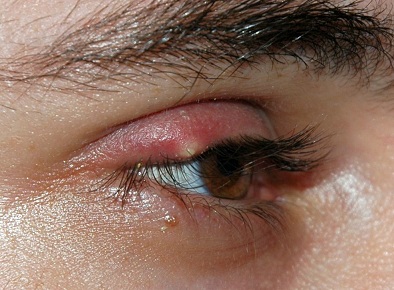Eyelids are essential in ensuring proper lubrication and protection of the eyes. Outflow of tears is facilitated by a special secretion of oil into a person’s eye, which is vital for its proper functioning. Hence, it is critical to prevent and avoid eyelid infections which are common for people of all age groups.
Eyelid infections usually occur when bacteria attacks the skin around the eyes. It could be brought about by a clogging of the sebaceous glands, also known as the oil glands that are found at the edges of the eyelashes. However, the two of the most common signs of an infection are inflammation and redness.
Types of Eyelid Infections
Although eyelid infections are a huge inconvenience and a sore sight to see, they are not extremely dangerous and are free of long-lasting damage to the eyes. Nevertheless, it is imperative that such infections be diagnosed and treated as soon as possible, because if neglected, they do have the potential to become dangerous.
1. Blepharitis
Blepharitis is a type of eyelid inflammation, which is usually caused by the growth of bacteria, viruses, an allergy or blockage in certain eyelid glands. It is a chronic condition meaning that it cannot be completely cured.
Symptoms: A person suffering with the infection commonly experiences reddening of eyelids as well as itchy, swollen, and scaly-appearance at the base of eyelashes. Oil glands may also become affected due to hormonal imbalance. For anyone suffering with Blepharitis, it is common to experience burning, dry eyes, blurry vision, and sensitivity to light, crusting of eyelashes, redness and swelling of eye or eyelid.
Treatment: Although Blepharitis cannot be completely alleviated, it can be treated by ensuring maximum eyelid hygiene. To avoid further damage, scarring or a possible injury to the eye’s tissue, proper care is essential.
- To control its effect, dipped a cloth in warm water then place it over your eye. Use it repeatedly depending on the need.
- Wrap your index finger in warm and wet cloth, then apply the diluted solution of baby shampoo or mild soap to your eyes.
- Cleanse each eye at a time with the use of a wash cloth by rubbing it over the lid margins and eyelashes.
Note: Application of testosterone eye cream to the eyelids can help if you have issues with oil glands. LipiFlow is a short, 12 minute procedure which helps in providing heat to the clogged glands and mild pressure for glands which require such treatment.
For more instructions, here is a video about Blepharitis:
2. Stye

Another commonly found eyelid infection is known as stye. A stye is a sore lump near the edge of the eye caused by an infection in the eyelash follicle. Bacteria are usually found on the skin harmlessly, and can cause infection in cases of damaged skin. Their occurrence is also caused by rubbing eyes with hands which carry mucus or bacteria. Stye may not necessarily cause harm to the eye and often disappear in a few days. However, they are often contagious. And in case the eyelid becomes infected completely, prompt medical treatment, including antibiotics, is usually required.
Symptoms: Common symptoms for the infection essentially include a red, tender and often painful lump on the eyelid. Such a lump is commonly found towards the edge of the eyelid. A ‘pointing’ is a case where the lump develops pus within it and develops a yellow looking covering. The feeling of ‘something in the eye’ is a common symptom and is often followed by irritation and watery eyes. In cases where the stye bursts releasing pus, the lump is treated quickly and the swelling goes down sooner.
Treatment:
- A hot compress is usually used for the treatment of styes. A hot compress may be made of cotton balls, which are heated in hot water and used to treat the infected eye and relieve pain. It is important to ensure that the material is hot, but not so much to cause any kind of burn. A repeated procedure of placing a hot material over the eye helps in treatment.
- Often times, medicines such as Paracetamol are also used for relief, along with a range of antibiotics which may need to be taken by mouth. Care must also be taken not to burst and squeeze the pus out of a stye deliberately, as it can cause further infection by spreading into the surrounding tissue. In case the stye remains hot and painful many days beyond treatment, consultation and a check up by a doctor is critical.
This video is a useful guide for how to deal with styes:
3. Eyelid Cellulitis
A severe form of eyelid infection is known as eyelid cellulitis. It is mostly caused by bacteria occurring due to a skin injury, sinuses or a certain insect bite on the eyelid. If not treated properly, this infection can get worse and spread to the rest of the face, causing facial swelling. In worst cases, the infection may also affect the orbit of the eye.
Symptoms: Common symptoms of Eyelid Cellulitis include redness, tenderness, swelling of the eyelid, eyelid burning, blurry vision, watery eyes, reduced vision, discharge or pus and often at times mild fever. In really bad cases of orbital cellulitis, headache, high fever, limited movement and loss of vision may be present.
Treatment:
- Warm compresses on the eyelid and face are used as common treatment procedures. It is recommended to avoid touching and rubbing the eye.
- The medical treatment requires the intake of antibiotics, and common choices amongst oral antibiotics include cephalexin, dicloxacillin, clindamycin, and augmentin. In the worst case, surgery may become necessary.
For more information about the infection, watch the video:
